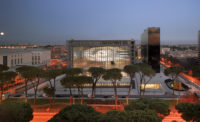With its facade faded to a patina and large patches of stucco missing to expose raw brick and concrete underneath, the reborn Scuderie Aldobrandini in Frascati, Italy, makes a varied statement about history and architecture. Transformed by Massimiliano Fuksas into a museum, gallery, and conference center, the Scuderie was once the horse stable of the Villa Aldobrandini, a masterwork of the late Renaissance by Giacomo della Porta. The stable has traveled on a sine curve of ruination and reinvention: The Germans used it as a regional headquarters during World War II; wine makers made it a fermenting house in the 1950s; and when Fuksas arrived in 1999, the structure was being used as a makeshift parking garage.
The client wanted space for exhibitions, lectures, and conferences, as well as for displaying its collection of archaeological artifacts. At any given time, the building might play host to a lecture on astrophysics, an exhibition on Bernardo Bertolucci, and a display of pottery shards from the 2nd century B.C. The architect was faced with a building shell requiring extensive reinforcing, as well as the challenge of integrating these diverse programs into a single structure.
Fuksas gutted the interior to expose the building’s raw structure—brick, stone, and plaster walls that date to the 1600s. The plaster was stabilized and a new steel truss apparatus added to tie the walls together and support a restored wooden roof. The architect then created two voids in the interior by inserting a three-story structure in the middle for service spaces. Each void was divided into two floors, for a total of four rooms—three for exhibitions, one for conferences. Museum director Giovanna Cappelli sits in a glass-and-steel office at the top of the central service space and enjoys views down through the glittering interior.
Splitting both first-floor exhibition rooms is a glass-enclosed trough that acts as a spine and contains individually mounted artifacts from Tuscolo, an ancient settlement nearby. Beneath the stands, artifacts are displayed in a glass-capped trench dug into the building’s floor. Unfortunately, the trench is not climate-controlled, resulting in an unintended (yet nonetheless interesting) murky subterranean cavern.
Adding a second story both increases the floor space and creates a dialogue between old and new. The new floor of glass and steel rests on a raw, rusting armature of structural steel. It seems to float aloft, separated from the old walls by a gap of several feet, which symbolizes an important design concept. Details like the Pompeii-red painted walls provide a skein of continuity for the disparate programs within the building
|
People Owner Architect Doriana Mandrelli, Lorenzo Accapezzato Interior designer: Engineer(s) Consultant(s) General Contractor Photographer |
Products Structural system Exterior cladding Glass curtainwall: Concrete: Roofing Windows Steel: Doors Paint: Floor and wall tile: Furnishings Reception furniture: Fixed seating: Chairs: Tables: Lighting Exterior: Plumbing
|









